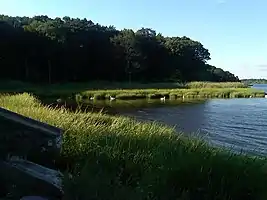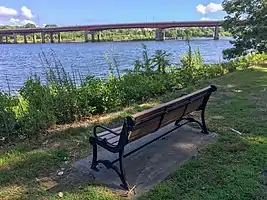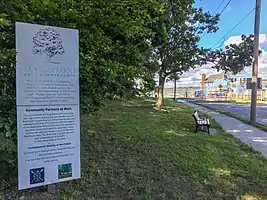Blackstone Park Conservation District
The Blackstone Park Conservation District is a public, 45-acre woodland conservation area on the East Side of Providence, Rhode Island. It is run by the non-profit Blackstone Parks Conservancy in partnership with the Providence Parks Department.[1][2] The park is situated on the west bank of the tidal Seekonk River, within the watershed and wildlife corridor of the Blackstone River Valley. Unlike many city parks, it is actively managed for the purpose of providing habitats for wildlife and supporting a healthy ecosystem for native flora and fauna.[2]
| Blackstone Park Conservation District | |
|---|---|
 Trail in Blackstone Park Conservation District | |
| Type | Urban park |
| Location | Providence, Rhode Island |
| Area | 45 acres (18 ha) |
| Created | 2003 |
| Operated by | Blackstone Parks Conservancy |




History of the site
The park is situated in an area where people of the Narragansett Indian tribe lived prior to the arrival of European settlers in the 17th century.[3] In the 1700s, the site was a part of the 300 acre farm owned by the merchant and abolitionist Moses Brown.[4] The area was subdivided by Brown's descendant Moses Jenkins in 1861 as the Blackstone Park Plat.[5] Jenkins donated five acres of land for a public park as part of the subdivision plan in 1866. Several decades later, in 1893, the city purchased eighteen acres from landowners for park development, with additional land acquired over subsequent decades.[5]
Ecology
Ecologically, the Blackstone Conservation District is a Northeastern coastal forest.[6] The woodland is dominated by broadleaf trees, predominantly oak, American beech, and black birch. The woods and shoreline are home to many species of shorebirds, gulls, owls and songbirds, as well as various small mammals. The ponds are home to several species of turtle. Along the Seekonk River, there are horse mussels, horseshoe crabs, and occasional harbor seals.[2]
Management and funding
The Blackstone Parks Conservancy and the City of Providence Parks Department jointly manage the Blackstone Park Conservation District.[2] In addition to public funding and private donations, the Rhode Island Coastal Resources Management Council (CRMC) provided partial funding to the Conservancy in 2020 for coastal upland edge restoration, to mitigate trail erosion.[7]
References
- "Neighborhood Parks". City of Providence Parks Department. Retrieved October 21, 2020.
- "Blackstone Parks Conservancy". Blackstone Parks Conservancy. Retrieved October 17, 2020.
- "Historical Perspective of the Narragansett Indian Tribe". Narragansett Indian Tribe. Retrieved October 17, 2020.
- Rhode Island Educational Circulars: Historical series, Volumes 1-6. Office of Commissioner of Education, State of Rhode Island. 1908. Retrieved October 17, 2020.
- "Blackstone Park Historic District - National Register of Historic Places Registration Form" (PDF). National Park Service, United States Department of the Interior. Retrieved October 18, 2020. Cite journal requires
|journal=(help) - "Northeastern coastal forest". World Wildlife Foundation. Retrieved October 21, 2020.
- "CRMC Funds Seven R.I. Habitat Restoration Projects". ecoRI News. April 8, 2020. Retrieved October 18, 2020.